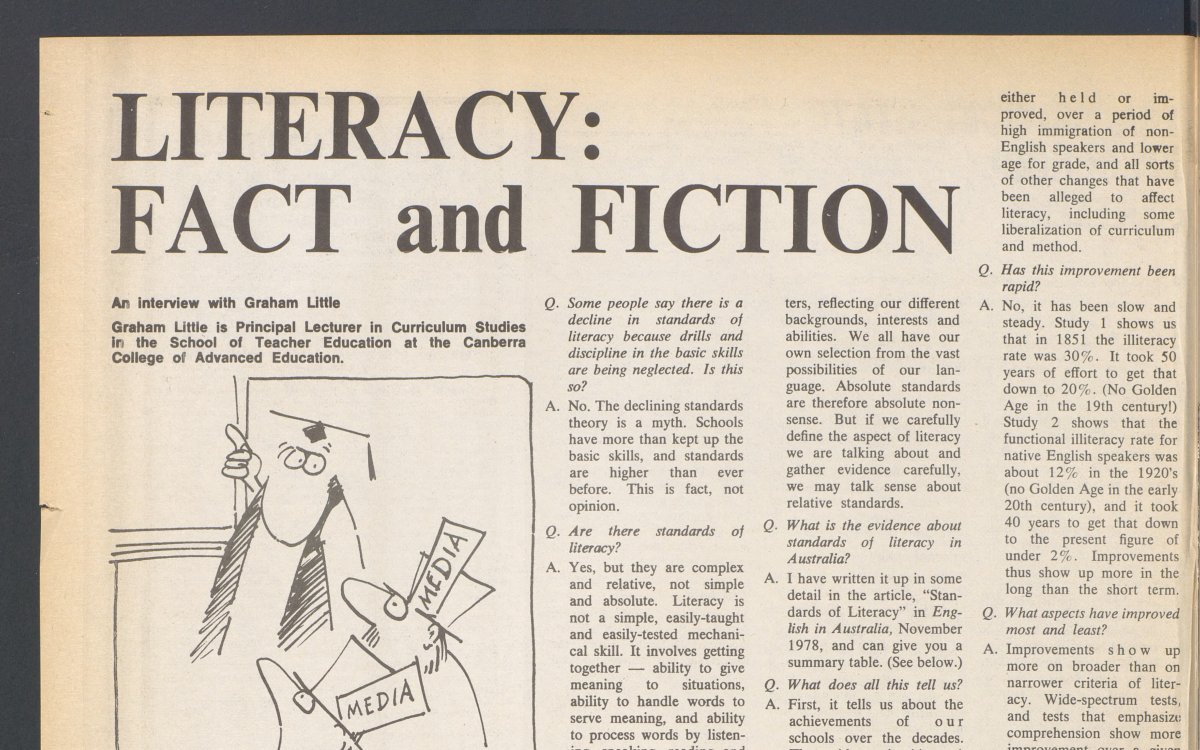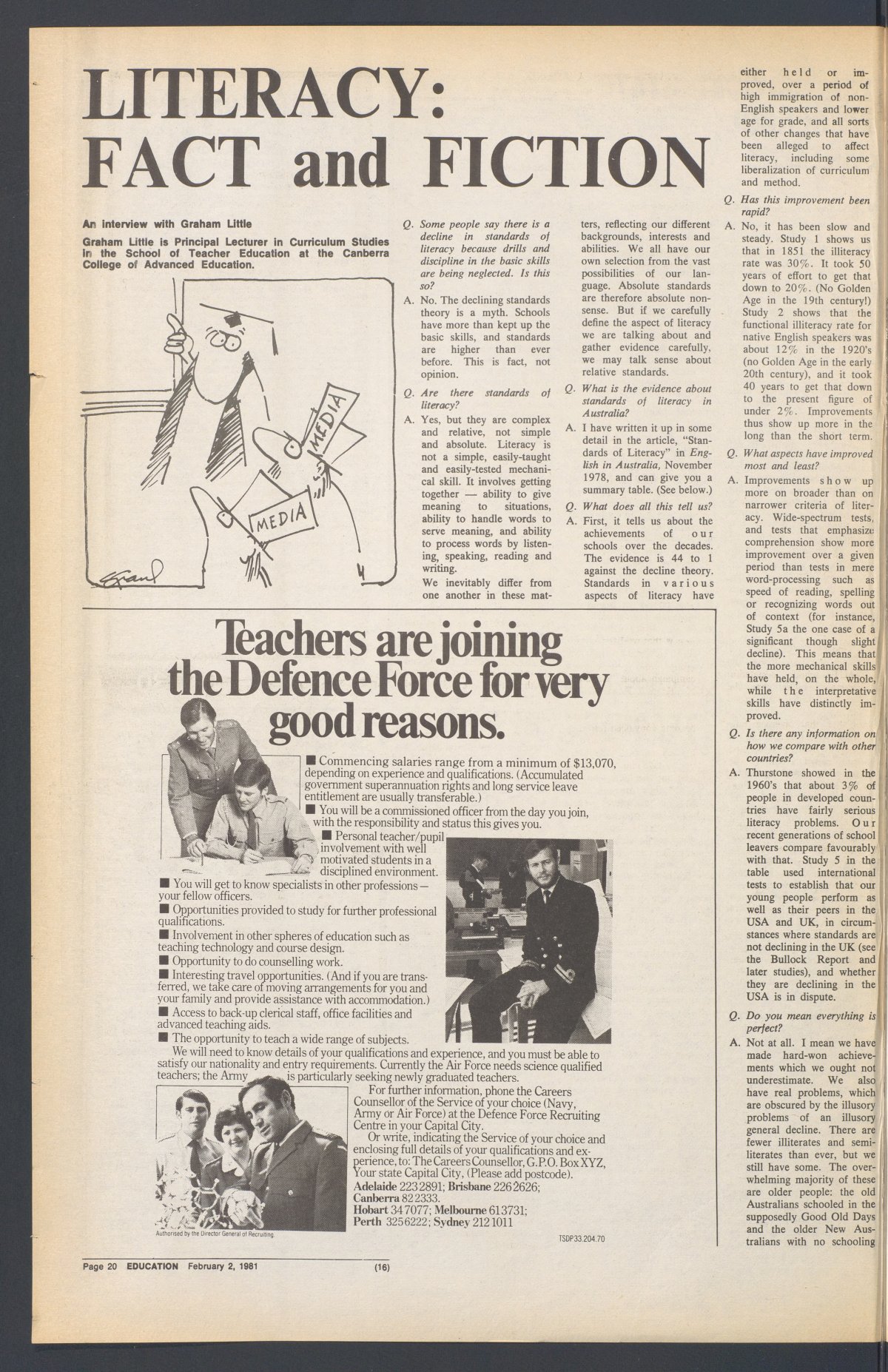
N.S.W. Teachers' Federation & New South Wales Public School Teachers' Federation. (1919). LITERACY: FACT and FICTION, Education : journal of the N.S.W. Public School Teachers Federation Retrieved October 27, 2023, from http://nla.gov.au/nla.obj-710682297
According to the Macquarie Dictionary, literacy has four meanings:
Noun
- the ability to read and write.
- the ability to use a language effectively.
- (plural literacies) an ability to comprehend communication and express oneself in a specified field: political literacy; arts literacy.
- an ability to use communications technology that is digitally based: computer literacy; multimedia literacy.
Broadly speaking, the use of literacy by itself usually describes a person’s ability to read and write and communicate (meanings 1 and 2); however, when combined with another word, literacy and its meanings can apply to a person’s ability to interact and understand that topic/area. For example, French literacy, sport literacy, and so on (meaning 3). The fourth meaning as described above relates most closely to digital literacy.
Media, information and digital literacy, by their most basic definitions, relate to a person’s skills and ability to locate, create, use and engage critically with information in a range of formats. While similar on a basic level, there are differences that set these competencies apart and often two or more may be used together, depending on the type of information, how it is presented and by whom.
Hear Michelle Ciulla Lipkin share her definition of Media Literacy:
Michelle Ciulla Lipkin talks about how literacies interact and co-exist:
Information Literacy
Information literacy is the ability to know when information is needed; how and where to seek relevant information; how to evaluate information for accuracy and bias; how to use information correctly; and how to create new information in a way that achieves a goal while acknowledging the creators of the source material.
The term “information” is broad and can apply to anything from which knowledge can be derived, including source materials such as books, photographs, video, websites, people, songs, sculptures and more.
Media Literacy
Media literacy, like information literacy, is rooted in having the skills and ability to access and analyse information for its purpose, accuracy and reliability, and being able to act using this information. Media literacy focuses on the ability to critically engage with information produced and distributed in the media, regardless of the format or outlet, in all aspects of life.
In Australia, news and news media is delivered and absorbed in a range of formats, with some of the most far-reaching being newspapers, magazines, podcasts, TV, radio, billboards and social media. On a global scale, the news cycle is ever present, with many channels streaming world events 24 hours a day, often reporting on events as they unfold with little or no information beyond what has been witnessed and reported already. Speculation and inaccurate information can often lead to misinformation taking root as truth, as outlets constantly push for “new” information to engage and retain audiences.
Hear Gavin Sundwall and Michelle Ciulla Lipkin discuss the 24/7 news cycle and how we can become better at evaluating the information it presents:
The Australian Media Literacy Alliance describes media literacy as “the ability to create, use and share media and to critically reflect on this engagement”. It is about having the ability to critique information that is presented in and by media outlets and having the skills to spot misinformation and bias, to discern fact from opinion, and to know how and when to check sources to evaluate claims and opinions.
Michelle Ciulla Lipkin discusses news shared through social media and techniques used to influence viewers:
Digital Literacy
Digital literacy, like information and media literacy, is also rooted in understanding and evaluating information as it is presented online, but moves beyond information analysis to being able to operate and exist safely and responsibly in a rapidly digitising world.
Australians consume a staggering amount of digital information every day. The Australian Competition and Consumer Commission’s Internet Activity Report (31 Dec 2021 to 30 June 2022) found there were 7.5 million NBN connections across households in Australia. The average data downloaded by NBN and non-NBN connections during the period was 436 gigabytes per month. Mobile data usage averaged 10.3 gigabytes per month.
Having robust digital literacy skills means considering that information and communications via digital means – including apps, social media, TV, radio and internet – can be created, edited, manipulated, and distributed by any individual or organisation with access to an internet connection. In many cases, false or misleading information can be widely and rapidly spread on digital platforms before administrators can act to remove it or place warnings asking viewers to consider the reliability of the source.
Strong digital literacy capabilities also help users to find and create a more positive digital engagement for themselves and others and give them the skills and confidence to call out misinformation or inappropriate material. Understanding the digital space and the tools used within it can make the job of spotting misinformation or altered information easier; for example, how filters work on social media, how people can edit images, what Artificial Intelligence (AI)-generated content can do and how to spot it. For many people, particularly older generations who did not grow up with or have not kept up with emerging tech, this can be very challenging.
Digital literacy skills also help users to have a presence in the digital world that safeguards them, their identity and their information. This includes knowing how to identify spam, phishing, or scam emails; understanding how, when and why their data is being captured and stored; having good account management and password etiquette; engaging with others on digital platforms in a way that is respectful, productive and safe; and knowing where and how to seek help and advice when issues and problems occur online.
